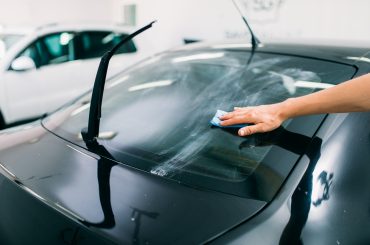Static cling window tint is applied directly to glass without the help of any adhesives. This is the best tinting option available for temporary tint requirements. This is an ideal window film for someone living in a rented apartment and having privacy concerns. Even though it is focused on temporary requirements, the window film can stay on the windows for years. Here is a detailed compilation of all the important facts that you need to know about static cling films.
Table of Contents
How Do Static Films Work?
Even though it uses the term static, no electrical charges are involved in it. It works simply by suction of air. This is the reason why they can be attached only on smooth, non-porous surfaces. So you need a perfectly even surface like glass to stick these films. Knowing how it works would help you identify the best places it would cling to. However, to understand this working principle well, it is necessary to know some science behind it.
The Science Behind Static Cling Window Tint
The static cling window tint is not attached to the window film using ant static charge or static electricity. The static electricity is generated when two surfaces contact one another and electrons move from one surface to another. Thus, the two surfaces would have positive and negative charges separately. So each surface would attract objects of the opposite charge and repel objects with the same charge.
However, window films are not attached to the window glass through this method. They cling due to the thin vinyl material, which acts as mini suction cups when pressed onto a surface with similar cohesive force. These similar surfaces bond perfectly with each other even at the slightest pressure applied. As no adhesives are required for this bonding, there won’t be any sticky residues left behind on the surfaces. This static film works best for indoor windows and can be used for any purpose in addition to window tinting.
How to Apply Static Window Film?
Static window film can be applied much more easily than films with adhesives. You can get your windows tinted efficiently by following these steps.
- Wipe and clean the windows thoroughly with a clean cloth.
- Measure the window accurately and note down the height and width.
- Mark it on the window tint film. You may use the grid on the backing paper as a guide for this.
- Cut the window film about 2 mm smaller than the measurements.
- Spray some soapy water on the glass to reduce friction. This is the key ingredient for the bubble-free application of static window film.
- Remove the backing paper of the static film by peeling it away.
- Apply the film on the window and press it with a hard edge to remove any water or air bubbles trapped in between the film and glass.
- Dry it gently with a cloth and let the film cure for few days.
Static Cling Window Tint For Home
Static window film can be used for Residential Window Tinting applications. Window films are applied for homes mainly for privacy concerns and to get protected from harmful sun rays. So these window films can be applied to home windows using the static cling method. You can choose various types of window films, such as frosted window films or even other decorative window films. There are static window films available for security and solar control purposes as well.
Static Cling Window Tint For Business
Various window films are ideal for commercial buildings related to security and energy efficiency. Laminated glass windows are a good option for the additional strength of commercial windows. Security window films provide additional safety for windows, while low-E window films provide high energy efficiency for the building. So, these window films can be installed using the static cling method for commercial window tinting.
Static Cling Window Tint For Car
As vehicles get more exposed to direct sunlight than building windows, they have many benefits of static cling window tint. This window film is less prone to damage as no adhesive damage occurs from sunlight. This will reduce the tendency to wrinkle, crease, and peel off like in window films with adhesives. This is possible for thin window films with less material content, such as the regular dyed film. There also are other types of car window film that can be fixed with static window clings.
Advantages of Static Cling Window Tint
- Traditional window tint is more likely to get bubbles very often due to damaged adhesive. The cling tint does not have any glue, and therefore, bubbles would not occur even years after installation.
- When traditional window film is pasted over debris by accident, there is no way of reversing the process. However, static window tints can be easily removed to clear any particles left under the film and can be readjusted.
- Static window films can be removed easily and do not leave behind any residues. They can even be rolled and stored away for reinstalling. But the traditional window films cannot be reused after removing. It is recommended to use a clear liner so that the film can be kept safe for later use.
- You don’t have to spend any additional labor costs on tint installation and removal, as you can do it yourself. This saves you more money than when using traditional films.
- Traditional window tints need heat guns for installation. But there is no additional equipment required for the application of static cling window tint.
Are Vinyl Clings the Same as Static Clings?
These are often misinterpreted as static clings. However, these are two types and have significant differences. Vinyl clings are made from heavy-duty material and hence are thicker and more robust than static clings. Even though vinyl clings can often be applied without any glue, they sometimes require some additional adhesive for the application. So they can be applied on many surfaces such as glass, wood, plastic, and wood. They can even be used for outdoor applications for long-term use. Removing vinyl clings requires some additional heat, unlike normal static clings.







